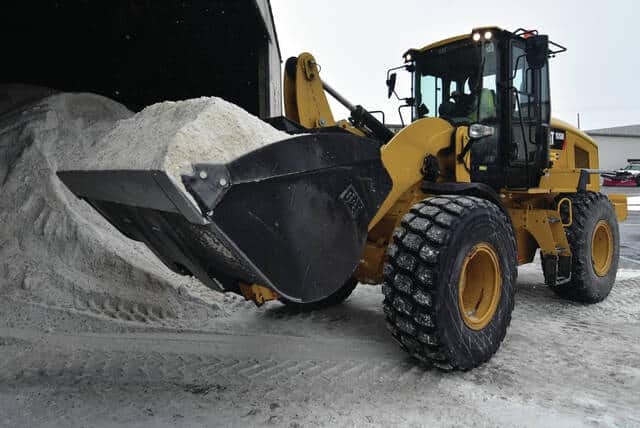
Brian Pencil of the City of Piqua loads salt into a storage barn at the Piqua City Garage.
Mike Ullery | Miami Valley Today
By Sam Wildow
MIAMI COUNTY — Local street and road departments are preparing for the projected winter storm to take place from 5 p.m. Wednesday through 7 a.m. Friday with crews planning to be out monitoring road conditions during the storm.
Miami County Engineer Paul Huelskamp said his department is monitoring the situation and the ongoing developments as to what kind of winter weather the area will get.
Huelskamp said, at first, freezing rain was predicted, which he said is “probably one of the worst things we can get as far as driving conditions.”
Now, the forecast for Miami County is rain that will shift over to snow.
“We can handle rain, and we can handle snow,” Huelskamp said, adding the department has de-icing materials they can use if sleet or freezing rain becomes an issue.
According to the U.S. National Weather Service in Wilmington, there will be hazardous travel due to “heavy snow to the north, freezing rain to the south, and winds to 25-30 mph through the day.” There will be a prolonged period of sleet in southern Ohio, including near the Dayton area.
For the Miami County area specifically, the National Weather Service’s winter storm warning states that heavy mixed precipitation is expected. The National Weather Service expects total snow and sleet accumulations of 4 to 8 inches and ice accumulations of up to one tenth of an inch. Winds will be gusting as high as 35 mph.
Crews from the Miami County Engineering Department plan to be out early Thursday morning, at around 3 a.m., to put de-icing materials on the roads before weather turns to freezing rain or snow. Crews will be available 16 hours, if not 24 hours, to work on clearing the roads.
“All of the trucks and everything are ready,” Huelskamp said.
The Miami County Engineering Department has approximately 3,000 tons of salt available, and Huelskamp explained the department mixes the salt with ice grit, which is crushed #9 limestone, to extend the county’s supply of salt and provide traction.
The rural areas are a point of concern during this winter storm as the high winds can have the potential to blow snow over the roads in those areas. When it comes to snow drifts, Huelskamp recommended that drivers don’t drive through them.
Huelskamp also recommended drivers give crews plenty of space and clearance when following behind snow plows. Crews may try to clear more space when coming up to intersections, requiring them to go in reverse to maneuver in different directions.
“The old saying is, ‘Ice and snow, take it slow,’” Huelskamp said. He added, if you have to go anywhere, “give yourself plenty of time, give yourself plenty of stopping distance.” If you don’t have to go anywhere, Huelskamp recommends staying home.
The cities of Piqua and Troy have snow removal priority maps published on their respective websites, including piquaoh.org and troyohio.gov.
The Piqua Public Works Department said the city’s priority streets are the streets that are most used by emergency services leading to hospitals and other emergency buildings. Following the cleaning of those streets, other streets are cleaned after the snow event is finished.
The city of Troy’s website states, “Primaries are streets classified as primary and secondary, which includes state routes, hills, bridges, and the streets immediately surrounding schools. Residentials include tertiary (branches off of Primaries) streets, local (or residential) streets, dead-end streets and cul-de-sacs.”
The city of Piqua offered the following safety tips when crews are salting and plowing:
• Give plow and salt trucks room to maneuver. When applying salt and plowing snow, plow drivers are required to change lanes, back up, make more frequent stops, and maneuver multiple times at intersection when removing snow from the roadway. It is important leave extra distance when following a plow truck.
• Don’t pass trucks when salt is being applied or snow is being plowed. Keeping control of your vehicle can be extremely difficult in snowy conditions, especially when driving behind or closely alongside the plow trucks as they are moving snow. If you see trucks out, roadways are likely slick or icy, so use extreme caution while driving.
• Don’t shovel snow into the street when clearing sidewalks, driveways, and parking lots. This makes clearing the roadway more difficult and creates more hazardous ice patches.
• Dig out fire hydrants. If there is a fire hydrant at your curb, please try to uncover it. The city does not have enough staff to do this after snow events.


